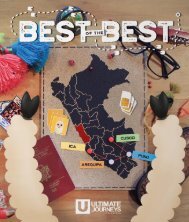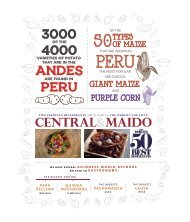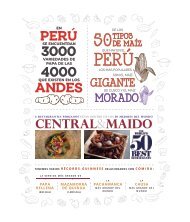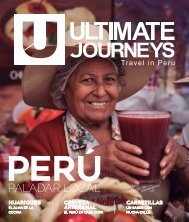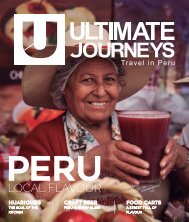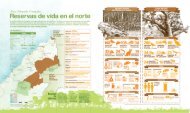UJ #19 - Sustainable Peru
You also want an ePaper? Increase the reach of your titles
YUMPU automatically turns print PDFs into web optimized ePapers that Google loves.
SUSTAINABLE TOURISM, THE IDEAL BALANCE<br />
Christian Declercq<br />
their resources, and thus, position themselves within<br />
the international market. This forces them to invest in<br />
bettering the quality of their services and to rely on<br />
specialised professionals for customer service needs.<br />
Nonetheless, tourism also has a negative side. Pollution,<br />
the exploitation of resources, the loss of cultural heritage,<br />
economic dependency, and chaotic urban development<br />
are only some of the unfortunate outcomes when a<br />
touristic destination fights to comply with the needs and<br />
requirements of tourists, while simultaneously working<br />
to keep up in the race to attract more and more visitors.<br />
<strong>Peru</strong>’s attractions –<br />
among them, Machu<br />
Picchu – captivate<br />
millions of people.<br />
LimaTours<br />
With all this in mind, sustainable tourism seems to be<br />
a balance between the much anticipated and needed<br />
growth of a given destination, and the protection and<br />
conservation of the attractions that strike global interest<br />
and bring people from around the world.<br />
WHAT IS SUSTAINABLE<br />
TOURISM?<br />
The UNWTO defines sustainable tourism as the one “that<br />
takes full account of its current and future economic,<br />
social and environmental impacts, addressing the needs<br />
of visitors, the industry, the environment and host<br />
communities.”<br />
Vinicunca, a<br />
destination that<br />
could be affected by<br />
the indiscriminate<br />
influx of tourists.<br />
Boasting incredible natural and cultural wealth – with 55<br />
native communities, 12 UNESCO World Heritage Sites,<br />
and over 60 protected natural areas – <strong>Peru</strong> not only has<br />
the potential to develop numerous programs that fit<br />
into this definition, but also offers a seemingly endless<br />
number of sites that would benefit from this kind of<br />
The purchasing<br />
of handmade<br />
products helps in the<br />
development of local<br />
communities and is<br />
an important part of<br />
sustainable tourism.<br />
In the last few years, the tourism industry has become<br />
one of the world’s most important, boasting surprising<br />
figures. According to the World Tourism Organization<br />
(UNWTO), the tourism business represents 10% of the<br />
global GDP, generating over 1,340,000 million dollars in<br />
income, in 2017 alone.<br />
With approximately 1,323 million people travelling<br />
around the world each year, one can only expect there<br />
to be some impact. Many of the developing countries<br />
of the world see tourism as a means to better use of<br />
12<br />
Christian Declercq




